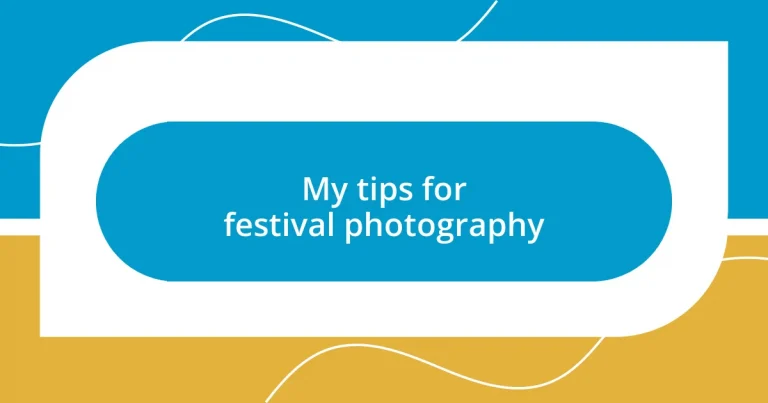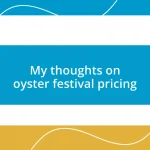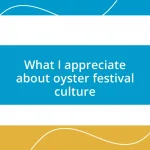Key takeaways:
- Understanding the festival environment, adjusting camera settings, and mastering lighting are essential skills for impactful festival photography.
- Choosing the right gear, including cameras and lenses, is crucial for capturing diverse moments and ensuring adaptability, while packing light helps avoid distractions.
- Effective photo editing and sharing experiences on social media enhance storytelling, allowing photographers to connect with others and convey the vibrant atmosphere of festivals.
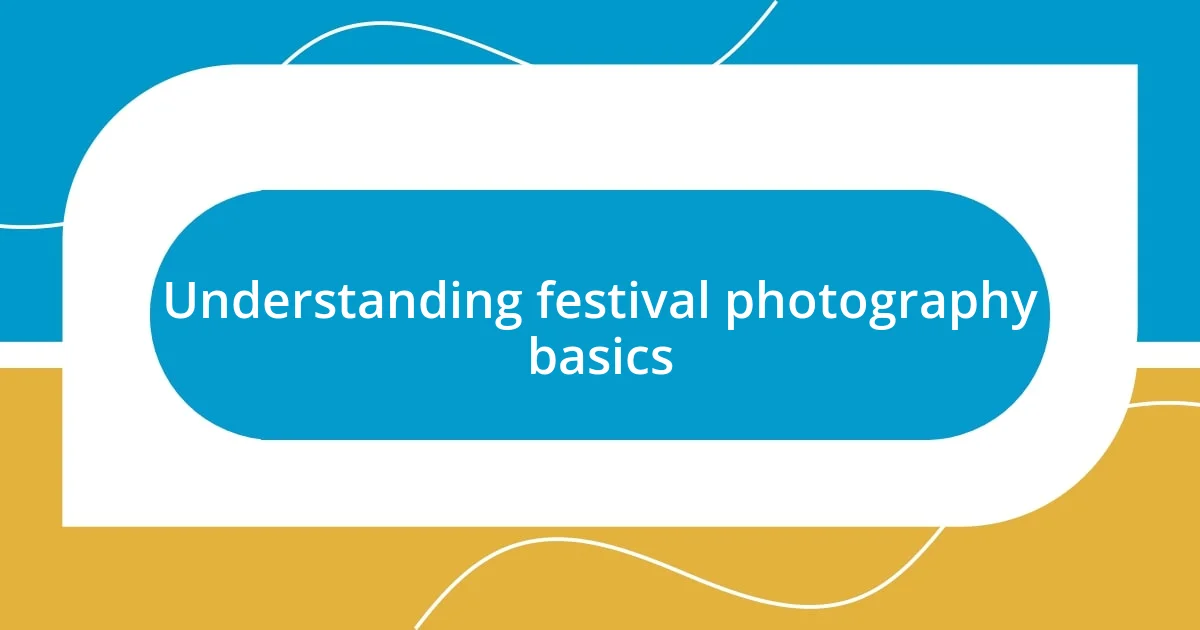
Understanding festival photography basics
When it comes to festival photography, understanding the environment is essential. I remember my first festival; the excitement in the air was palpable, yet I quickly learned that it was also chaotic. From the vibrant colors to the dynamic movements, I realized that capturing these moments required more than just pointing and shooting. It took practice and attentiveness to truly convey the energy around me.
Lighting plays a crucial role in festival photography. I’ve made the mistake of relying too much on auto settings, which often left my photos lacking depth and vibrancy. Festivals typically involve varied lighting conditions, especially as the sun sets and artificial lights come to life. Have you ever noticed how the atmosphere changes with just a shift in light? It’s like a completely different world! Understanding how to adjust your camera settings accordingly can elevate your images significantly.
Composition is another vital aspect that can enhance your storytelling. I often find myself framing shots that focus on both the performers and their audience. There’s something magical about capturing the connection between the two. Don’t you think it adds a layer of emotion to your photos? Experimenting with different angles and perspectives can reveal moments you might not have noticed at first, making your festival photography truly stand out.
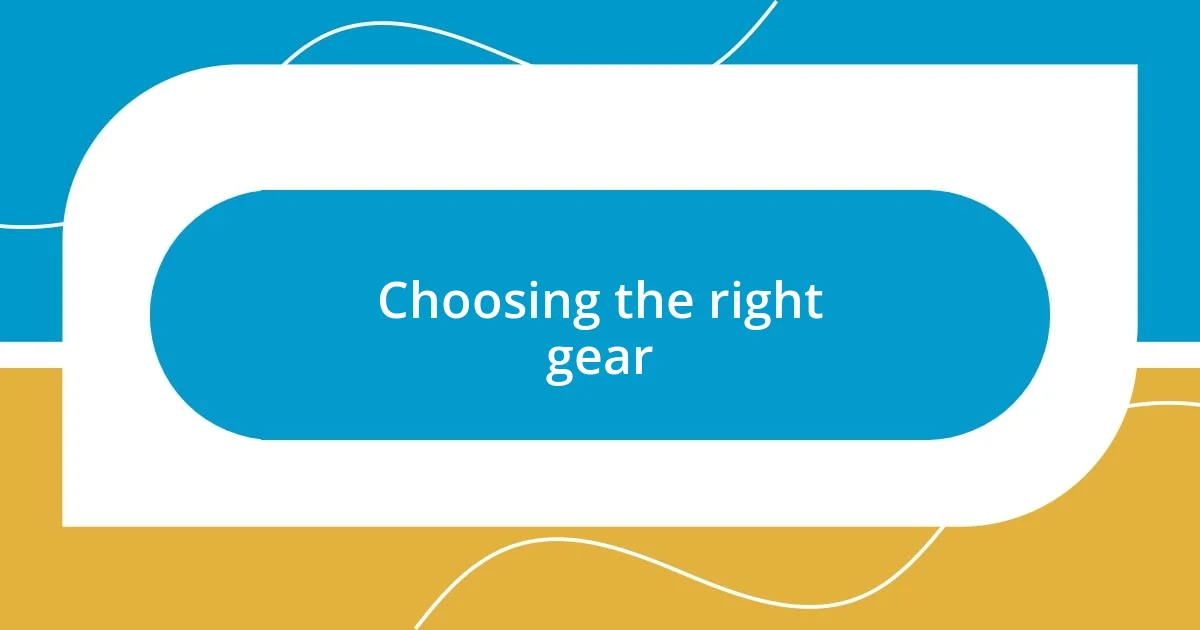
Choosing the right gear
Choosing the right gear is a crucial step in elevating your festival photography experience. I can’t stress enough how my choice of camera and lenses transformed my shots at a music festival last summer. While many friends relied solely on their smartphones, I opted for my DSLR with a versatile zoom lens. The results were night and day—capturing both candid moments in the crowd and up-close details of performers added depth to my portfolio.
When considering gear, keep the following in mind:
- Camera Type: DSLRs or mirrorless cameras offer better quality and control over settings.
- Lenses: A fast lens (with a low f-stop number) works wonders in low light; a zoom lens is great for flexibility.
- Stabilization: A tripod or stabilizer can help with long exposure shots, especially as the crowds get wild.
- Memory Cards: Bring extra—festivals can run long, and you don’t want to miss a moment due to storage issues.
- Weather Protection: Invest in a rain cover or a weather-sealed camera, just in case the weather doesn’t cooperate.
I’ve also learned the hard way to pack light. At one festival, I overburdened myself with gear and ended up missing spontaneous moments because I was more focused on lugging my equipment around rather than capturing the joy around me. Knowing the right tools for the job, and having the confidence to adapt, can truly transform your photography journey.
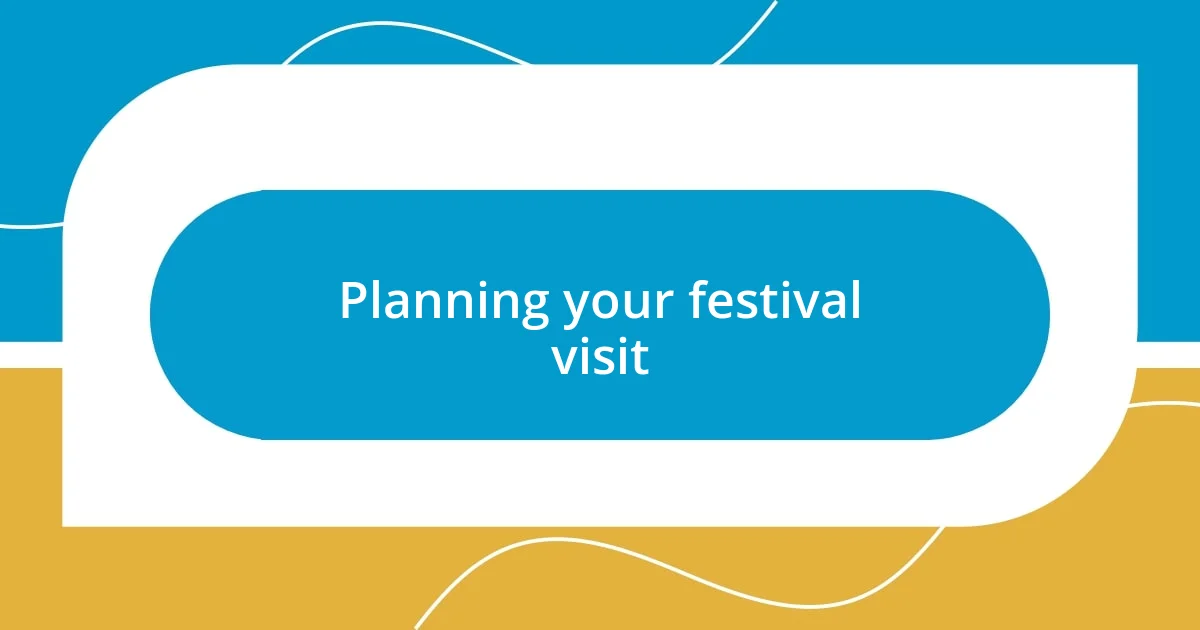
Planning your festival visit
When it comes to planning your festival visit, I recommend carefully considering the lineup and schedule in advance. I’ve found that making a detailed plan helps me prioritize the artists I want to see, while still allowing room for spontaneity. One year, I missed out on an incredible artist simply because I hadn’t double-checked the time and ended up in the wrong place. Trust me, a little planning can save you from the disappointment of missing your favorites!
Another essential aspect of your festival planning is understanding the venue layout. Familiarizing yourself with the stages, food areas, and rest zones really enhances the experience. I’ve noticed that festivals can feel overwhelming if you’re darting from stage to stage without a clear sense of direction. Taking a moment to map out key locations can help you navigate the crowds with ease and even discover hidden gems along the way, like that quirky craft booth I stumbled upon last summer.
Lastly, don’t forget to consider your travel and accommodation logistics. I’ve learned the importance of booking early and factoring in how long it’ll take to get to the festival site. During one event, I ended up in a last-minute hotel that was miles away, and it added a lot of stress to the whole experience. Having a solid travel plan helps ensure that you can fully enjoy the festival vibe without unnecessary distractions.
| Key Consideration | Tips |
|---|---|
| Music Lineup | Identify must-see artists and create a flexible schedule. |
| Venue Layout | Study the map beforehand to navigate easily. |
| Travel and Accommodation | Book early and plan transport routes to reduce stress. |
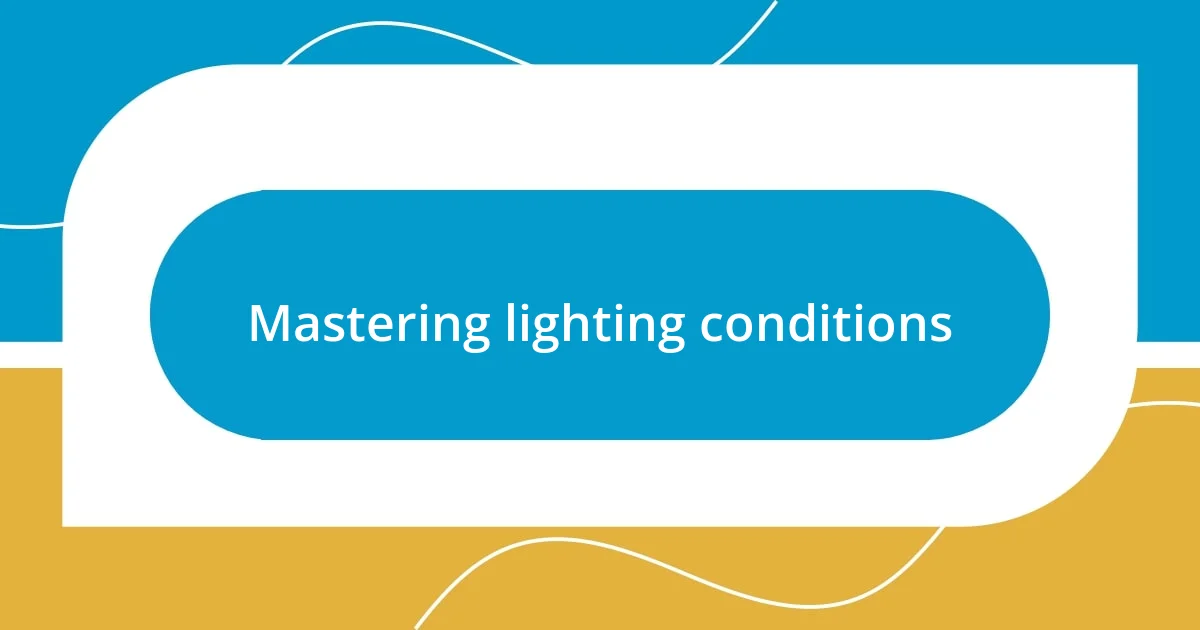
Mastering lighting conditions
When it comes to mastering lighting conditions, I can’t emphasize enough how much of a difference natural light can make. I remember standing in the middle of a vibrant sunset at a festival, the colors enveloping the crowd like a warm hug. That soft, golden hour light can create ethereal images that simply pop; it’s all about finding the right moments to take advantage of it. Have you ever felt that rush when the lighting aligns perfectly with your shot?
In low-light situations, like when the headliners take the stage, I’ve found it essential to adjust my camera settings accordingly. Increasing the ISO will help gather enough light, but I always keep an eye on noise levels, ensuring my images remain crisp. I once shot a performance under dimmed lights where I cranked up the ISO too high, resulting in grainy photos. Lesson learned! A fast prime lens can be a game changer here, allowing me to capture the atmosphere without sacrificing quality.
Don’t forget to be aware of artificial lighting effects, which can add drama but also play tricks on your camera. I once struggled with neon lights that washed out my subjects, making them look flat. By experimenting with white balance settings, I finally found the sweet spot, and the vibrant colors came alive in my photos. It’s a thrill to watch the dance between light and shadow unfold through my lens. How do you tackle lighting challenges in your photography?
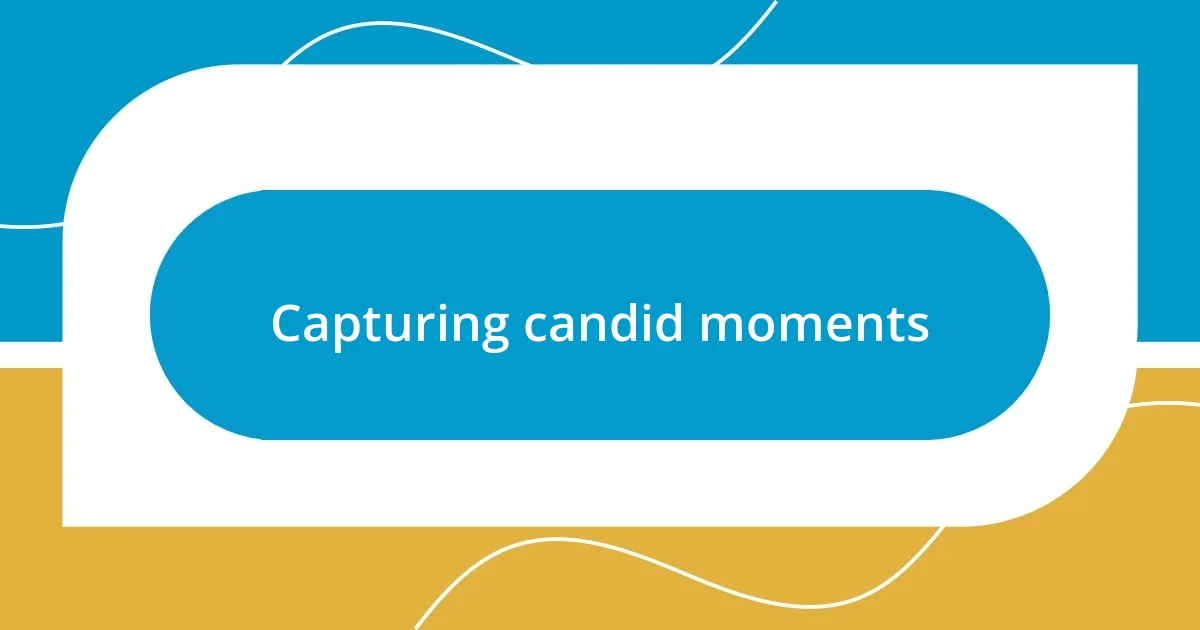
Capturing candid moments
Capturing candid moments at a festival is one of the most rewarding aspects of photography. I always find myself with my camera on standby, ready to snap those spontaneous bursts of joy and connection between people. There was a time when I caught a glimpse of two strangers bonding over their favorite band, their laughter illuminating the surrounding chaos. It’s those fleeting interactions that tell the real story of a festival, drawing viewers into the vibrant atmosphere and evoking genuine emotions.
One technique I’ve embraced is to blend into the crowd, allowing my presence to feel unobtrusive. I recall a moment when I grabbed an unposed shot of a girl dancing joyously, completely lost in the music. By keeping my distance and letting the festival spirit unfold around me, I’ve discovered that I can capture raw, authentic expressions that resonate with the viewer on a deeper level. Have you ever paused to observe the little details, like the way a child clutches a balloon or how friends huddle close during performances?
Timing is crucial for those unexpected shots. I often hold my breath and wait for the perfect second when emotions explode—like the moment a musician reaches out to the audience, or when the crowd erupts into a collective cheer. Once, I experienced a powerful wave of energy when a surprise act hit the stage, and I managed to capture the audience’s euphoric reaction just as it peaked. It’s moments like these that remind me why I love festival photography in the first place—every click of the shutter is a chance to encapsulate joy, spontaneity, and the essence of the festival experience.
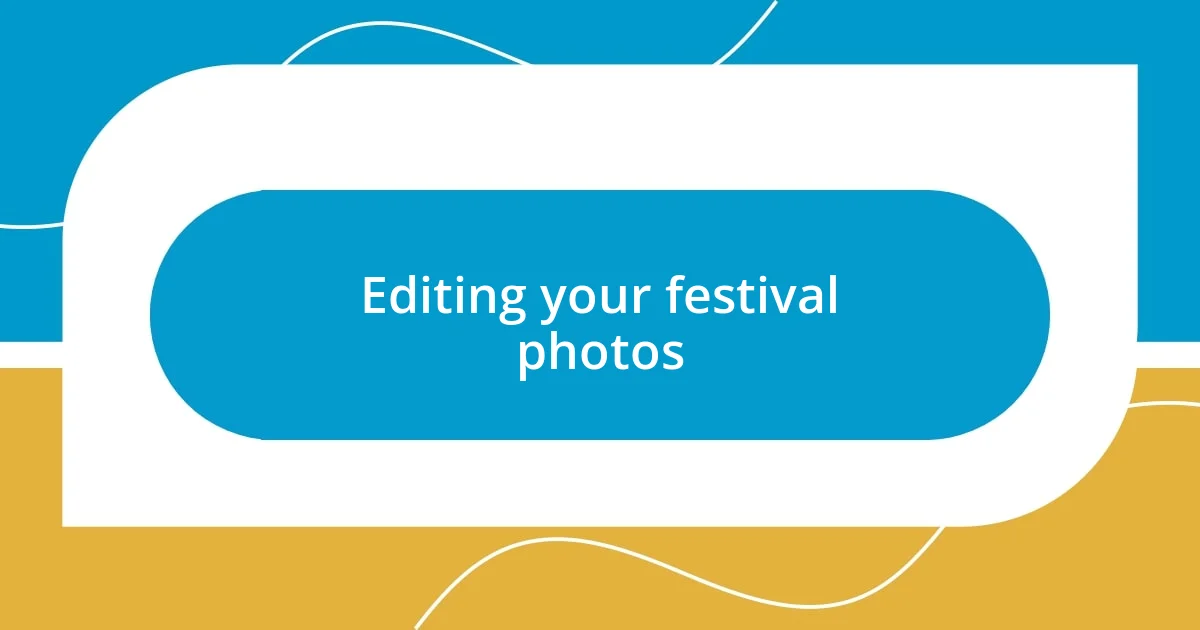
Editing your festival photos
Editing your festival photos can truly transform raw images into captivating stories. I remember returning home after my first festival, excited to relive the moments I captured. As I sifted through an array of shots, it became clear that good editing was essential to convey the vibrant energy I experienced. Do you ever feel that your photos lack the same spark they had in the moment?
One effective approach I’ve adopted is to start with basic adjustments like exposure and contrast. It’s fascinating how a simple tweak can make the colors pop and the details stand out. For instance, I once tackled a photo of a lead singer backlit by stage lights. By increasing exposure slightly and adjusting the contrast, I could suddenly see the emotion in their face—a moment I almost lost to shadow. Have you experienced the magic of bringing an image back to life during editing?
When it comes to stylization, I love experimenting with filters and color grading to match the festival’s mood. A particular software I enjoy using allows me to apply preset styles that echo the vibe of the event. I recall editing a sunset shot where the sky was a kaleidoscope of colors. By enhancing those hues and adding a slight vignette, I created a dreamy effect that drew viewers in. It’s a creative process that not only hones my skills but also allows me to narrate festivals through my unique lens. How do you find your editing style evolves with each festival you capture?
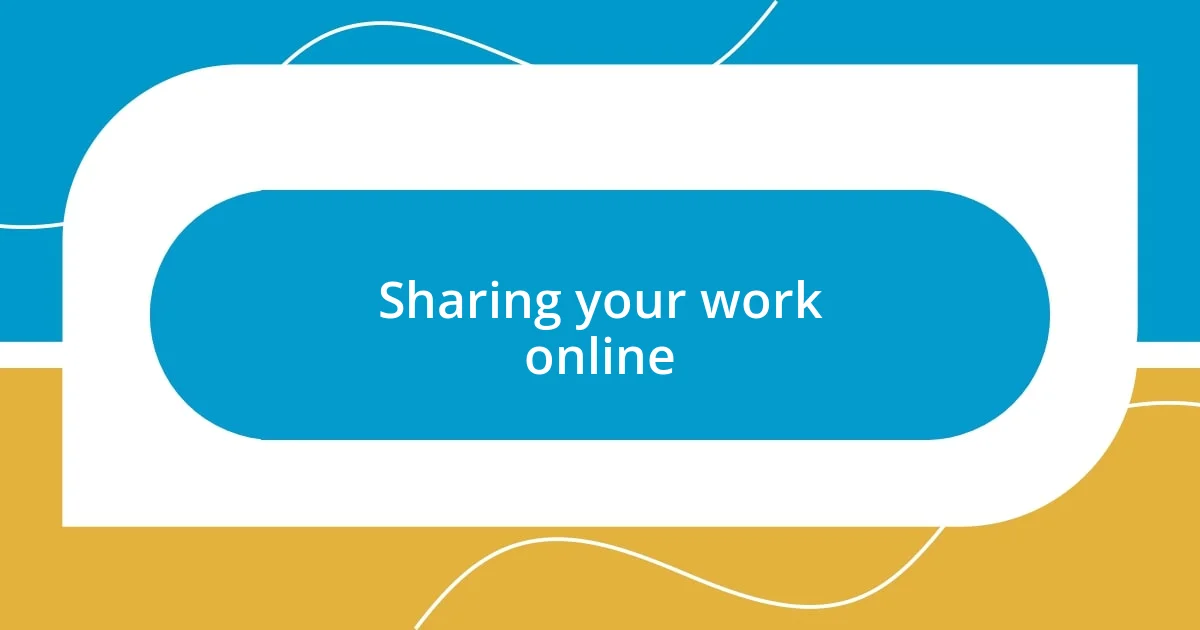
Sharing your work online
Sharing your photography online can be an exhilarating way to connect with fellow enthusiasts and showcase your work to a broader audience. I remember the first time I posted my festival shots on social media; the rush of support and feedback actually gave me a new sense of validation. Have you felt that thrill when someone recognizes the effort and creativity behind your shots? It’s truly a rewarding experience.
Choosing the right platform is crucial. For instance, I lean towards Instagram because its visual-centric nature allows my images to shine. Engaging with a community of photographers and festival-goers, sharing behind-the-scenes stories, and even using popular hashtags has significantly increased the reach of my work. Have you explored the importance of hashtags? They can amplify your visibility and connect you with others who share your passion.
Ultimately, don’t shy away from telling the story behind each image. I often accompany my posts with anecdotes about the moments captured, like the time I spotted a breathtaking sunset while the crowd swayed in unison. When I share those stories, people don’t just see a photo; they feel the atmosphere, the excitement, and the shared experience of the festival. How do you choose to narrate your photography journey?












